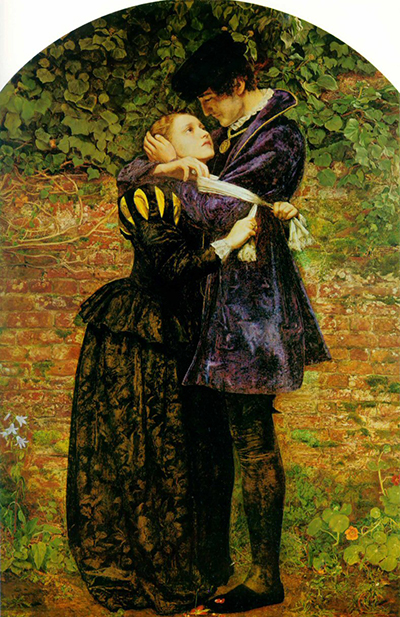A Huguenot also known as A Huguenot, on St. Bartholomew's Day, Refusing to Shield Himself from Danger by Wearing the Roman Catholic Badge is an oil on canvas painted by artist John Everett Millais in 1852.
The title of the painting refers to the historical event of St. Bartholomew's Day massacre in 1572, a day in which some Huguenots (French Protestants) were massacred and killed in Paris and in some other parts of France because of their religion. That day some Huguenots managed to escape from Paris by wearing white armbands, shielding themselves from danger by showing Roman Catholics symbols.
During the sixteenth Century Huguenots had gained a big influence in France and had started to display more openly their faith, causing the rise of Catholic hostility that eventually exploded in a series of religious conflicts knows as The French Wars of Religion.
This painting depicts an intense and meaningful scene of two lovers engaging in a romantic embrace. The young man on the right of the picture is the Huguenot of the title. At a glance the scene may seem sweet and familiar, but looking closely a dramatic detail can be seen. In fact, the girl in trying to get her beloved to wear a white armband, in a desperate yet gentle attempt to save his life.
Being a symbol of loyalty towards the Roman Catholicism, the armband would protect the young man from being killed, but he refuses to wear it by gently pulling it off with his left hand, the same with which he cuddles and embraces the girl.
Formally speaking the painting features only dark colors, mainly black and dark green, the only white spot is the white armband. Millais is basically conveying through colors the same emotions and meanings that the context contains: the only light in the uncertainty, the only hope of salvation is the armband.
This isn't the only symbol the artist uses in the painting, in fact some art critics suggested that also the flowers carry a profound meaning. The Blue Canterbury Bells that can be seen at the left of the scene are indeed a symbol of constancy and faith.
Millais chose the subject after being persuaded by William Holman Hunt, one of his Pre-Raphaelite colleagues. At the time, the Pre-Raphaelites were constantly attacked for their alleged proximity to Catholicism and the Oxford Movement, so Millais decided to depict a pro-Protestant subject hoping to dispel doubts about him and his colleagues; Millais also took inspiration for the painting from the French opera in five acts "Les Huguenots" by Giacomo Meyerbeer, which premiered in 1836 in Paris.
The painting was originally exhibited with another famous painting by the same artist: Ophelia (1852).




